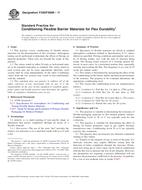Potrebujeme váš súhlas na využitie jednotlivých dát, aby sa vám okrem iného mohli ukazovať informácie týkajúce sa vašich záujmov. Súhlas udelíte kliknutím na tlačidlo „OK“.
ASTM F392/F392M-11
Standard Practice for Conditioning Flexible Barrier Materials for Flex Durability
Automaticky preložený názov:
Štandardná prax pre úpravu Pružné ochranné materiály pre Flex Trvanlivosť
NORMA vydaná dňa 1.4.2011
Informácie o norme:
Označenie normy: ASTM F392/F392M-11
Poznámka: NEPLATNÁ
Dátum vydania normy: 1.4.2011
Kód tovaru: NS-55137
Počet strán: 3
Približná hmotnosť: 9 g (0.02 libier)
Krajina: Americká technická norma
Kategória: Technické normy ASTM
Anotácia textu normy ASTM F392/F392M-11 :
Keywords:
barrier, barrier materials, flex crack, flex resistance, flexible, gas permeation, gas transmission rate, pinhole , water vapor transmission rate, WVTR, Flexible barrier materials, Durability, Flex durability, ICS Number Code 55.040 (Packaging materials and accessories)
Doplňujúce informácie
| Significance and Use | ||||
|
This practice is valuable in determining the resistance of flexible-packaging materials to flex-formed pinhole failures. Conditioning levels A, B, or C are typically used for this evaluation. This practice is valuable for determining the effect of flexing on barrier properties such as gas and/or moisture transmission rates. Conditioning levels D or E are typically used for this evaluation. This practice does not measure any abrasion component relating to flex failure. Failures in the integrity of one or more of the plies of a multi-ply structure may require different testing than the detection of holes completely through the structure. Permeation tests using gas or water vapor can be used in conjunction with the flex test to measure the loss of ply integrity. However, any permeation test requiring a pressure differential will not measure the permeation coefficient in the presence of pinholes. For a list of test methods refer to Guide F2097. The various conditions described in this procedure are to prevent testing a structure under conditions that either give too many holes to effectively count (normally greater than 50), or too few to be significant (normally less than five per sample). Material structure, purpose for testing and a mutual agreement between parties involved are important points to consider in the selection of conditioning level for testing. |
||||
| 1. Scope | ||||
|
1.1 This practice covers conditioning of flexible barrier materials for the determination of flex resistance. Subsequent testing can be performed to determine the effects of flexing on material properties. These tests are beyond the scope of this practice. 1.2 The values stated in either SI units or inch-pound units are to be regarded separately as standard. The values stated in each system may not be exact equivalents; therefore, each system shall be used independently of the other. Combining values from the two systems may result in non-conformance with the standard. 1.3 This standard does not purport to address all of the safety concerns, if any, associated with its use. It is the responsibility of the user of this standard to establish appropriate safety and health practices and determine the applicability of regulatory limitations prior to use. |
||||
| 2. Referenced Documents | ||||
|
Odporúčame:
Aktualizácia technických noriem
Chcete mať istotu, že používate len platné technické normy?
Ponúkame Vám riešenie, ktoré Vám zaistí mesačný prehľad o aktuálnosti noriem, ktoré používate.
Chcete vedieť viac informácií ? Pozrite sa na túto stránku.




 Cookies
Cookies
